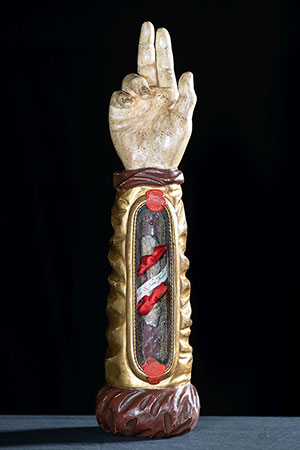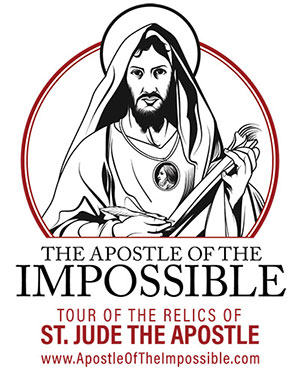Don’t miss this ‘house call’ by an Apostle
 Centuries after he was martyred and his body entombed in St. Peter’s Basilica, St. Jude’s arms were removed and placed in reliquaries in the shape of a priestly arm imparting a blessing. St. Ann Church will host one of those relics Feb. 15, when “Apostle of the Impossible: the Tour of the Relics of St. Jude the Apostle” comes to Charlotte. (Photo provided by Apostle of the Impossible Tour)CHARLOTTE — When things seem hopeless or unbearable, Catholics have a friend in St. Jude.
Centuries after he was martyred and his body entombed in St. Peter’s Basilica, St. Jude’s arms were removed and placed in reliquaries in the shape of a priestly arm imparting a blessing. St. Ann Church will host one of those relics Feb. 15, when “Apostle of the Impossible: the Tour of the Relics of St. Jude the Apostle” comes to Charlotte. (Photo provided by Apostle of the Impossible Tour)CHARLOTTE — When things seem hopeless or unbearable, Catholics have a friend in St. Jude.
St. Jude, one of the Twelve Apostles and among the most beloved of all the saints, is called the “Saint of the Impossible” – the one people turn to when they are desperate and have tried everything else.
Now, some of St. Jude’s physical remains – two large pieces of his forearm bone encased in a wooden reliquary – are coming Feb. 15 to St. Ann Church in Charlotte, where they will be displayed for veneration.
The visit is part of a special U.S. tour of the relic, the first time it has traveled outside Italy. Charlotte is one of three tour stops in North Carolina and the only one in the Diocese of Charlotte.
Father Timothy Reid, St. Ann’s pastor, is excited to host St. Jude’s relic and expects “a grace-filled day.”
“Being in the presence of a saint’s relic is an opportunity to have an experience with that saint, a chance to pray to that saint in a particular way,” he says.
“Everybody is welcome,” Father Reid emphasizes. He especially invites people who are sick, especially with cancer or incurable diseases.
Father Reid, who has a personal devotion to St. Jude, says, “He’s very good.”
He credits the saint with miraculous healings and cures, as well as helping people find jobs, assisting infertile couples to conceive, and resolving financial problems.
“What’s nice about St. Jude is that he’s a multi-faceted saint who can take on any issue that seems impossible. You can go to him for absolutely anything.”
Father Reid encourages visitors to open their hearts to God’s grace, whether or not they experience a miracle.
“People should come with a lot of faith but at the same time, if your prayers aren’t answered the way you like, trust that God has a plan for you,” he says. “No matter what, you are going to come away with a sense of peace.”
He’s encountered many saints’ relics in Rome and around the world, he says, and “I’ve never walked away from a saint’s tomb without feeling a little bit better and more joyful.”
Now, he adds, “You don’t have to travel to Rome – he’s coming here to us. He’s making a house call!”
The “Apostle of the Impossible” U.S. tour is organized by Treasures of the Church, an evangelization ministry led by Father Carlos Martins of the Companions of the Cross, a biographer of St. Jude and a Church-appointed curate of relics with over 30 years’ experience.
WHO WAS ST. JUDE?
 Wikipedia “Saint Jude Thadddeus,” by Georges de La Tour (1620). According to ancient tradition, St. Jude and his fellow apostle St. Simon the Zealot were martyred around 65 A.D., probably in Beirut. They share a feast day, Oct. 28. St. Jude is believed to have been axed or clubbed to death, so he is often depicted holding a club and an image of Christ.Jude Thaddeus was one of Jesus’ Twelve Apostles. Little is known about him other than that he was Jesus’ cousin and had several brothers including James, another of the original Apostles.
Wikipedia “Saint Jude Thadddeus,” by Georges de La Tour (1620). According to ancient tradition, St. Jude and his fellow apostle St. Simon the Zealot were martyred around 65 A.D., probably in Beirut. They share a feast day, Oct. 28. St. Jude is believed to have been axed or clubbed to death, so he is often depicted holding a club and an image of Christ.Jude Thaddeus was one of Jesus’ Twelve Apostles. Little is known about him other than that he was Jesus’ cousin and had several brothers including James, another of the original Apostles.
The New Testament Epistle of Jude is named for him, although scripture scholars disagree on whether he was the author.
Catholics invoke St. Jude when in desperate situations because the Epistle of Jude stresses that the faithful should persevere even when facing harsh or difficult circumstances.
Historical evidence indicates Jude and fellow apostle Simon the Zealot preached in Mesopotamia, including present-day Iraq and parts of present-day Iran, Kuwait, Syria and Turkey. He and Simon are believed to have been martyred around the year 65 A.D., probably in Beirut. Their bodies were later brought to Rome and placed in a crypt in St. Peter’s Basilica.
Several centuries ago St. Jude’s arms were removed and placed in reliquaries in the shape of a priestly arm imparting a blessing.
It is one of those reliquaries – carved from wood and kept in a shrine at the Church of San Salvatore in Lauro near St. Peter’s Basilica – that pilgrims will see on the tour.
— Patricia L. Guilfoyle Sources: “Apostle of the Impossible” website and CatholicOnline.org
Tour details
Date: Thursday, Feb. 15
Location: St. Ann Church, 3635 Park Road in Charlotte
Schedule: 1-10 p.m. veneration, 7 p.m. Mass in honor of St. Jude
Cost: Free. Proceeds from an offertory collection and sales of holy cards and medals will go toward the restoration of St. Jude’s Shrine in Rome, where the relic is housed.
Parking: Church lot and on-street parking available
Line-up: Upon arrival, go to the north side of the Allen Center to join the line. Avoid the area around St. Ann School during student dismissal between 2 p.m. and 3 p.m. Veneration will pause for Mass at 7 p.m.
On site: You will be able to touch the reliquary and touch objects of devotion to it. You may also touch photos of family or friends to it to invoke St. Jude’s intercession.
Note: Confessions will be available. Visitors may receive a plenary, or full, indulgence with the usual conditions.
Questions? Call the St. Ann Parish Office at 704-523-4641.
More online
At www.apostleoftheimpossible.com: Learn more about St. Jude and the U.S. tour of his relic.
At www.catholicnewsherald.com: Watch a 2-minute video by Father Carlos Martins, leader of the “Apostle of the Impossible: the Tour of the Relics of St. Jude the Apostle” tour.
At www.praymorenovenas.com/st-jude-novena: Prepare for the saint’s visit by praying a novena.



